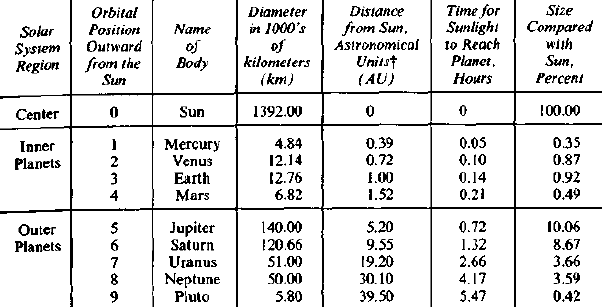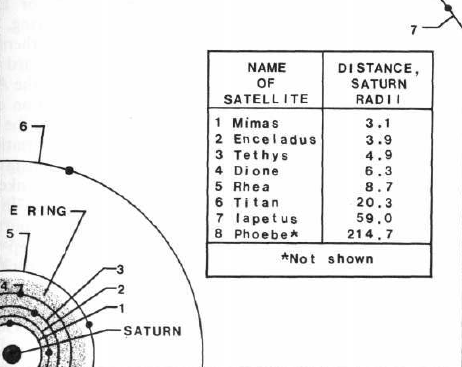|
IMPEDIMENTS TO PROGRESS
This situation changed little until the beginning of the 17th century when Galileo and his contemporaries, using telescopes, began systematic observations of Saturn.
Variance among observers and the uncommon appearance of the rings have been attributed to poor telescope quality in early days.
The observer, W. R. Dawes, carefully concluded in 1862 that the rings must be inconceivably thin.
Another puzzlement has been the sighting of one arm of the ring when the other arm could not be detected.
Two astronomers, Maurice Ainslie and John Knight of Great Britain, observed the source independently. Brightness of the source was so intense that Ainslie referred to the object as a "star". The star traveled a straight-line course which, in effect, subtended a chord across the ring system. Length of the chord was of the order of 125,000 km (77,700 mi).
Observed time to traverse this chordal distance across the ring system was 1 hour and 40 minutes, making the average velocity 21 km/sec (13 mi/sec). This value compares with an average velocity for Voyager en route to Saturn of about 13.7 km/sec (8.5 mi/sec). That is, the star was about 1 1/2 times faster.
During the observations when the star was in plain view, the light therefrom appeared to be elongated. There was a strange aspect about the traversal itself. Seeming to move through the ring plane without difficulty, the star appeared to devour material ahead as it proceeded. Further, at no time did the rings completely block out the radiating light.
For example, so-called "spokes" of light stretch across part of the ring system; the F ring, which is positioned alone outside the main ring plane, contains entwined strands or "braids"; intense electrical discharges similar to, but much greater than, terrestrial lightning have been recorded; and Saturn's moon Iapetus is about 10 times, or one order * of magnitude, brighter on the sun-shadowed side than on the sun-exposed side.
* An estimate of magnitude expressed as a power of 10.
This value is about twice those reported at the turn of the 18th century, and over an order of magnitude greater than measurements obtained during the onset of the 20th century.
The problem is how to explain such a wide spread in measurements of the same thing. Pressure mounts to recognize all ring-thickness values as being approximately correct at the time obtained. Such recognition, however, requires discarding a belief that 20th century telescopes could yield vastly better gross ring-pattern definition than 18th century telescopes.
Then, when new data are received which do not conform to the fixed ideas, an impediment to progress is experienced.
The reported variance in ring-plane thickness is a really good example. A preconceived idea which tacitly has become fixed is that ring thickness should be a constant, whereupon, variable thicknesses are intolerable. An impersonal method for dispensing with unwanted measurements has been to attribute variances plausibly to poor-quality telescopes.
Notwithstanding the tendency to dispose of untoward data, another part of the answer to the question is that something in or about the data is being overlooked. Oversight unobtrusively is convenient when fixed ideas are being promulgated. However, oversight also can occur because of presumptive expectations that confirmative new findings will be obtained. Important facts have an uncanny tendency to remain obscure.
On an absolute scale, 17th and 18th century telescopes admittedly were not sophisticated. However, recorded differences in ring-system configurations were made with nearly equally unsophisticated telescopes. Therefore, while minutiae concerning ring shapes can be questioned, gross differences in form most likely are valid.
Conversely, when a plurality of mechanisms is required to explain several events, the correct explanation almost certainly has not been found. In the former instance, no coincidences are required. In the latter instance, unlikely coincidences are required. Existence of concurrent happenings, or a multiplicity of sequential happenings, only can be hypothesized.
Introduction of coincidences into an analysis potentially is fraught with error.
Pieces of the Saturn puzzle are presented in an ordered manner.
Consequently, the reader is urged to proceed as though each chapter is a prerequisite to the subsequent one.
As a class, the largest and brightest single objects are star-like radio sources called quasars. An example is quasar 3C-273, estimated to be about a light- year * across and to produce energy equivalent to about 10 trillion suns.
* Distance traveled by a particle moving at the speed of light for a year.
This object is located so remotely that its signals, traveling at the speed of light, require about 30 million centuries to reach earth. Indeed, the universe is a place in which huge immensity abounds. Memory of this characteristic is essential when shifting thought from familiar terrestrial physical sizes to unfamiliar, extraterrestrial ones.
Being only about 1/1000 light-year across the outermost planetary orbit, our solar system is small compared with the size of quasar 3C-273.
Yet spatially, the solar system is quite immense. For example, the distance between the sun and its outermost planet Pluto is 3.7 billion miles. Sunlight requires about 5 1/2 hours to journey there; and a spacecraft traveling at only 34,000 miles per hour would require 1 1/4 decades to make the same trip. In the solar system, 9 planets orbit the sun.
These bodies are enumerated in Table I to illustrate comparative size and position.
Diameters of all the inner planets are less than one percent that of the sun. Earth slightly out-ranks Venus in size with a diameter of nearly 1/100 (0.92 percent) that of the sun. Except for Pluto, all planets in the outer groups have diameters greater than 3.6 percent of the sun's. Of all planets, Jupiter is the largest with a diameter slightly exceeding 1/10(10.1 percent) that of the sun.
Saturn is second largest with a fractional comparative diameter of 1/11 (8.7 percent).
An appreciation of the relative spacing of the planets
with respect to the sun can be obtained by noting time for sunlight
to be received. Inner planets receive light from the sun ranging
from only 3 to 13 minutes (0.05 to 0.21 hours).
TABLE I
In contrast, outer planets receive light ranging from about 3/4 to 5 1/2 hours.
As between Earth and Saturn, the time differential for a light signal is almost 1 1/4 (1.32 minus 0.14) hours. This time corresponds to the shortest orbital distance between the two planets of 8.55 (9.55 minus 1.00) astronomical units, or 794.3 million miles.
However, limited speed and load-carrying capability of 20th century spacecraft preclude extensive excursions in or beyond the solar system. Significant improvement in this restricted ability to travel extraterrestrially awaits the application of nuclear power to space flight-propulsion systems.
Analyses must be directed toward pin-pointing, in a timely manner, specific worthwhile objectives for succeeding flights. A long wait, say 10 years, before data from a flight are digested comprehensively, does not permit plans for subsequent flights to benefit very much from prior experience.
Apropos, six years after launch, Voyager flights returned no compelling reasons for undertaking further flights to Saturn or to any other part of the solar system.
These rings span 22 earth diameters and extend on either side of the planet an equivalent of 1.13 Saturn diameters. Sufficient consistency in plan-form of the ring plane has been displayed over time such that designations could be assigned to various regions.
Starting from the outer edge of the ring plane and progressing inward, four rings have been designated: A, B, C and D.
A narrow separation occurs in the outer extremity of the A ring called the Enke * division, after the discoverer Johann Enke. The A and B rings are considered non-contiguous, being separated by a space called the Cassini division after the Italian-born French astronomer.
* Also called by some authors the Keeler division or gap, for American astronomer, James E. Keeler.
The inner edge of the B ring also constitutes the outer edge of the C ring.
The D ring fills a space from 1.1 Saturn radii to the inner edge of the C ring, a ring having a so-called "crepe" texture. Additional radial designations are not consecutive, owing to the chronological order of discovery. For example, before Voyager 1, a faint ring located between about 3 and 8 Saturn radii had been assigned the next alphabetical designation, E.
Then Voyager 1 found two rings between the A and E rings. These latter two rings have been designated F and G, with the F ring being innermost.
Enumerated in progressively outward orbital locations from Saturn, the spherical satellites are:
The first four, Mimas, Enceladus, Tethys and Dione, lie within the radial expanse of the E ring.
Rhea, at 8.7 Saturn radii, orbits closely
outside the E-ring outer edge (8.0 Saturn radii). Titan, Iapetus and
Phoebe are quite remote, being at about 20, 59 and 215 Saturn radii,
respectively.
Plate 1 Rings and Spherical Satellites of Saturn.
Radius of Saturn
is 60,330 km (37,490 mi). Practically all irregularly-shaped satellites occupy the zone between the A and G rings.
Two of these, 1980S27 and 1980S28, are unique in that they orbit tightly astraddle the F ring. This particular pair has been designated "shepherding" satellites.
Mimas, Enceladus, Tethys, Dione, Rhea and E ring are close to Saturn compared with the outer satellites Titan, Iapetus and Phoebe.
Considering the Saturn-system boundary defined by the orbit of the outermost satellite Phoebe, the system diameter is 26 million km (16 million mi). Also equivalent to 0.17 astronomical units, the system span measures about half the distance between the Sun and the innermost planet Mercury (0.39 AU).
An exemplary case in point is the Enke division.
After Professor Enke's announcement concerning discovery of a gap in the A ring, some observers could not find the alleged separation at all. Others who succeeded reported the gap located at various distances inboard of the A-ring outer edge.
Distance of the Enke gap inboard from the A-ring outer edge can be expressed non-dimensionally as a fraction of the entire A-ring radial width. Fractional-distance locations of the Enke gap inboard of the A-ring outer edge show appreciable variation as follows: 0, 1/4, 1/3, 2/5 and 1/2.
According to these data, constancy of location within the A ring definitely is not an attribute of the Enke gap.
An impression is conveyed that latest reported measurements purport to be the true ones when, in reality, all might be quite nearly correct at time of observation. General reluctance to accept variable ring-system geometry occurs because of apparent failure to identify a physical mechanism suitable for producing recurrent change.
By scaling the photograph along the ring major
axis, the Enke division is found located a fractional distance of
1/5 the A-ring width from the
ring outer edge. This value is at the low end of the historical
range of reported values.
Saturn, second largest planet in the solar system, exhibiting circularly complete rings.
Separation of the A and B rings by the Cassini division also is evident in Plate 2.
This division shows as a clear space across the face of Saturn, then as a dark and broad continuous arc throughout the remainder of the ring. Ratio of the A-ring breadth to the B-ring breadth scales 3 to 5. On the same scale, Saturn is 21.6 units in diameter.
For an equatorial diameter of Saturn equal to 120,660 km, apparent width of the A and B rings is about 16,750 km (10,400 mi) and 27,930 km (17,350 mi), respectively.
Distance of the Enke division from the A-ring outer edge is calculated to be 3350 km (2080 mi). Obviously, large distances photographically are compressed into an exceedingly small space. The A ring illustrates well this high degree of compression.
Width of the A ring is equivalent to about an 18-hour non-stop jet flight between Montreal, Canada and Melbourne, Australia. Yet in the photograph, this great distance is represented by only 6/10 cm (1/4 inch).
Mental cognizance and retention of this high-compression characteristic during examination of subsequent photographs is helpful to their comprehension.
|



